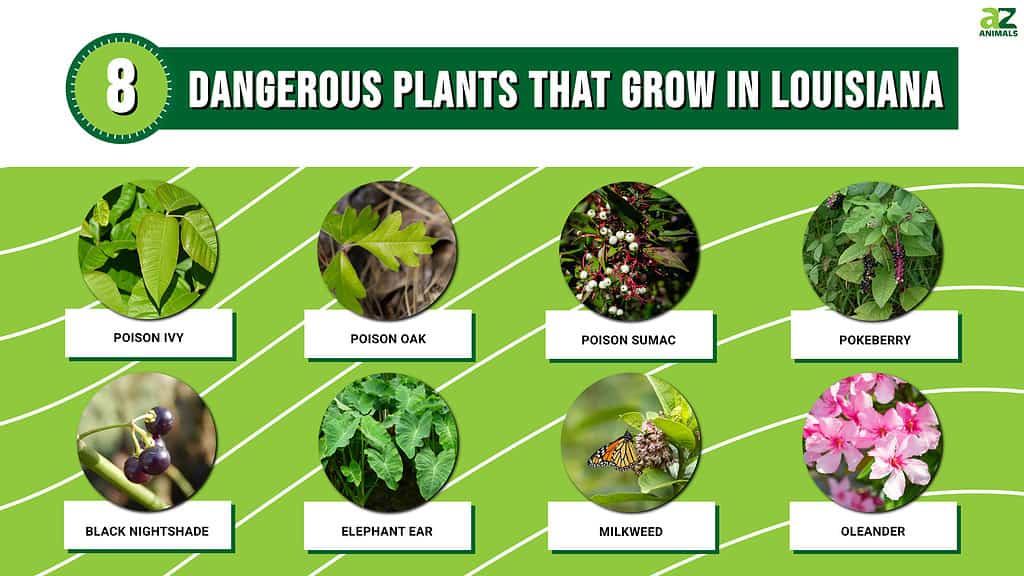
Louisiana is known for its beautiful magnolia trees, colorful wildflowers, and many more incredible plants to admire. But Louisiana fields, meadows, and woodlands also have poisonous plants. Knowing which plants are toxic is important for avoiding mild to life-threatening allergic reactions from touching or ingesting them. So beware of the eight dangerous plants that grow in Louisiana from our list below. You’ll want to avoid them entirely or take extra precautions when handling or getting near them.
However, not all of the dangerous plants in the United States should be destroyed. While these plants can be dangerous for humans, pets, and livestock, it’s important to note that some are essential food sources for other animals, like birds, bees, and butterflies. For this reason, it’s a good idea to research a plant’s possible benefits before destroying or removing it.
Have you already been exposed to a poisonous plant? See our tips below for getting quick info and support.
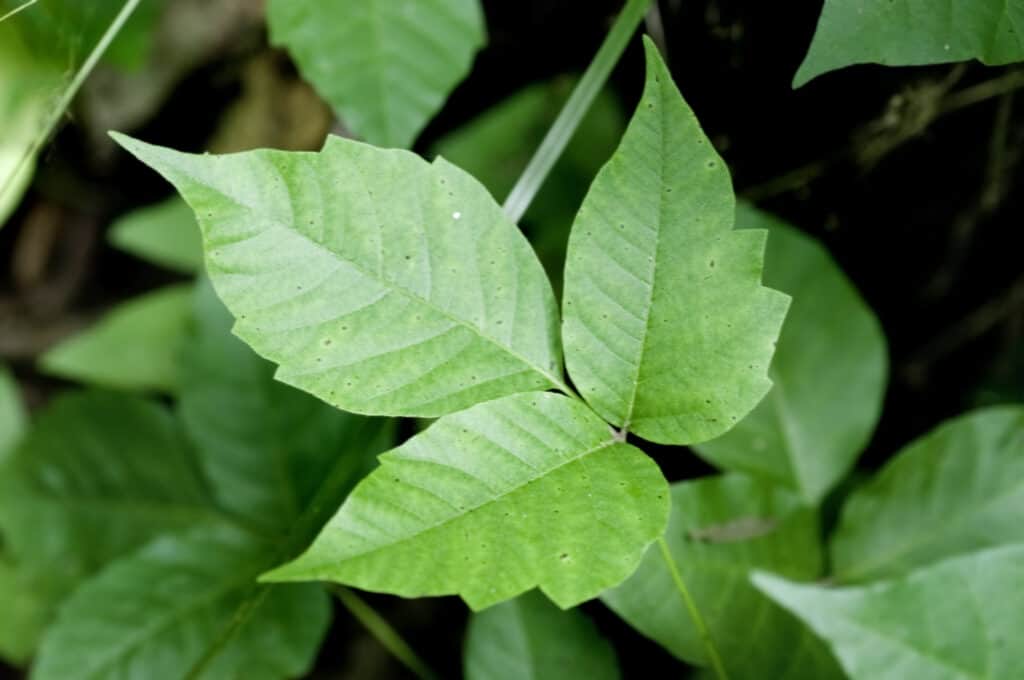
Allergic reactions are common with poison ivy exposure but can be prevented with extra precautions.
©Tim Mainiero/Shutterstock.com
Plant Poisoning Treatment
In the US, contact poison control for help treating symptoms from plant poisoning. And there’s more guidance available from the CDC plus National Institute for Occupational Safety and Health website.
Plant Safety Precautions
Of course, preventing allergic reactions to poisonous plants whenever possible is even better. Toward that goal, here’s a quick checklist of plant safety precautions to consider:
- Bring a small plant identification guide with you in areas where plants are unfamiliar to you.
- If a plant is unfamiliar to you, don’t touch it.
- Wear some long pants, long sleeves, and gardening gloves to protect your skin. Wash all clothing immediately to avoid the transfer of toxins from the fabric.
- Keep children and pets away from unfamiliar and toxic plants.
Pack a small first aid kit for outdoor adventures. The first aid kit should include the following:
- Anti-itch lotions (calamine and antihistamine)
- Baking soda to help soothe itching
- Degreasing soap for removing plant oils
- Disinfectant wipes
- Small scrubbing brush for fingernails
According to the FDA, over-the-counter protectants like zinc acetate, zinc oxide, and zinc carbonate might help dry up oozing blisters from poison oak, poison sumac, and poison ivy. So ointments with these ingredients could be another staple item for your first aid kit.
And it’s a good idea to be familiar with the poisonous plants you could encounter when enjoying the great Louisiana outdoors. So keep reading to learn more!
1. Poison Ivy
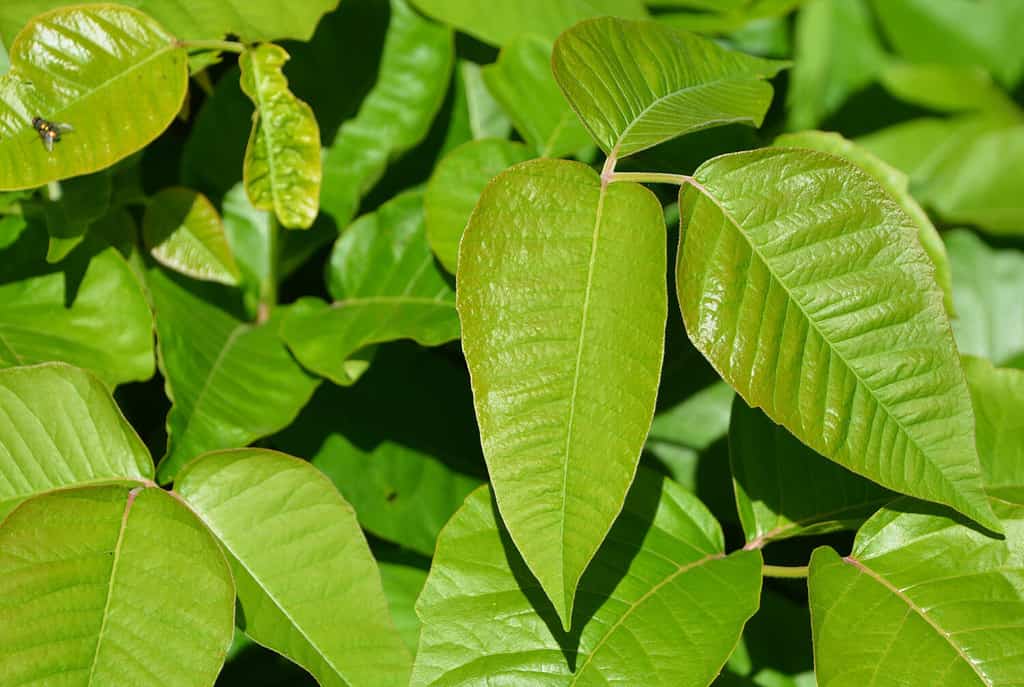
Humans and pets should avoid touching or eating any part of the poison ivy plant.
©meunierd/Shutterstock.com
- Scientific Name: Toxicodendron radicans
- Common Names: Poison ivy, Eastern poison ivy, markweed
- Plant Description: One of the easiest ways to recognize poison ivy is by its light green leaves that grow in sets of three. As the saying goes, if the plant has leaves of three, leave it be! This plant’s leaves can be glossy or dull, with smooth or jagged edges plus pointed tips. Poison ivy plants also produce yellow-green flowers that turn into white berries in late summer. Also, be aware that this plant’s leaves turn reddish in autumn.
- Height at Maturity: Poison ivy is a climbing and trailing plant that can reach many feet long. For example, this plant can climb by its roots up to 75 feet high along structures like fences and tree trunks.
- Habitat: Along sunny trails, roadsides, forest edges, and woods
- Toxic Parts of Plant: All parts of poison ivy should be avoided, whether the plant is alive or dead.
- Plant Poisoning Symptoms: Touching poison ivy could cause an itchy rash, redness, swelling, and blisters. Inhaling fumes from burning poison ivy could cause severe lung pain and difficulty breathing. Do not eat any part of poison ivy plants, including their berries. Eating poison ivy could cause severe pain and damage to the digestive tract and kidneys.
Poison ivy is a common dangerous plant that grows in Louisiana, especially in woodland areas of the state. And poison ivy is harmful to touch and eat because of an oily mix of compounds it produces called urushiol. Coming in contact with urushiol causes mild to severe allergic reactions in most people and many animals.
Animals That Don’t Experience Poison Ivy Symptoms
Some animals love eating poison ivy leaves, stems, and seeds, so this plant does have circle-of-life value! According to the United States Geological Survey (USGC), the following list includes some of the many wild animals that feed from poison ivy plants in Louisiana:
- Black bear
- Crow
- Mockingbird
- Muskrat
- Pocket mouse
- Sparrow (many species)
- Woodrat
- Woodpecker (many species)
Though it’s fascinating that some animals enjoy snacking on poison ivy, many cannot tolerate it and suffer serious allergic reactions to it. So keeping children, pets, and livestock away from this poisonous plant is essential.
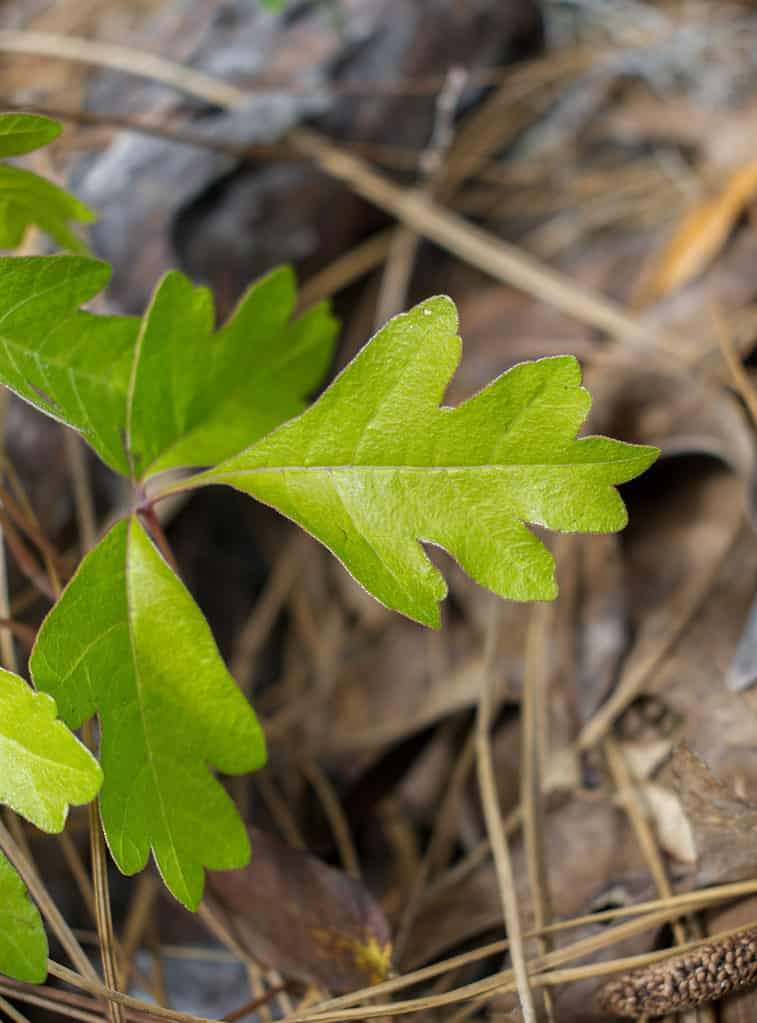
Atlantic poison oak is a dangerous plant that grows in grasslands, woodlands, and coastal regions.
©iStock.com/Dan Rieck
2. Poison Oak
- Botanical Name: Toxicodendron pubescens
- Other Common Names: Atlantic poison oak, Eastern poison oak
- Plant Description: Atlantic poison oak is a short shrub with lobed oval leaves and white flowers that turn into yellow-green or white berries. The leaves have tiny hairs and grow as leaflets of three.
- Height at Maturity: This poison oak variety usually grows 4-10 feet high, but sometimes taller
- Habitat: Poison oak grows in coastal regions, grasslands, river edges, and woodlands. It thrives in wet soil in shady areas under trees and other tall vegetation.
- Toxic Parts of Plant: Avoid all parts of poison oak, whether the plant is alive or dead.
- Plant Poisoning Symptoms: Redness, swelling, itchy rash, and blisters could result from touching any part of a poison oak plant. Eating the berries or other parts of poison oak could also cause diarrhea and vomiting.
Atlantic poison oak is a low-growing shrubby plant with textured leaves and yellow-green or white berries. According to LSU AgCenter, poison oak grows across the Atlantic and Gulf Coast Plain Regions of the United States, including Louisiana. And touching any part of this dangerous plant can cause an uncomfortable rash with blisters.
This type of poison oak is sometimes confused for poison ivy, and both plants contain the oil urushiol. When this oil gets on your skin from touching or brushing against the plant, that’s when things get itchy or worse.
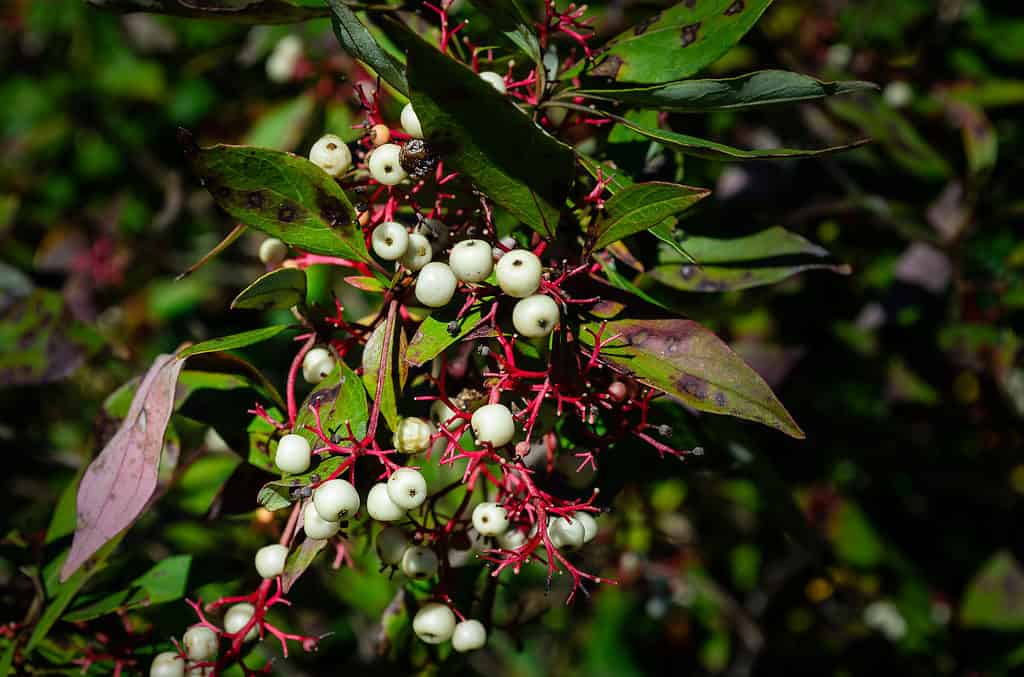
Touching poison sumac could cause an uncomfortable skin rash with watery blisters.
©iStock.com/Grb
3. Poison Sumac
- Scientific Name: Toxicodendron vernix
- Common Names: Poison tree, poison elder, shrub oak, thunderwood, swamp sumac
- Plant Description: Beware the poison sumac plant with its hanging white or greenish berries. This dangerous Louisiana plant is a woody shrub with red stems and smooth, oval leaves. And its leaves grow in pairs of 7-13 leaflets in a long row.
- Height at Maturity: 5-24 feet high
- Habitat: Poison sumac loves areas with wet soil, including areas around bogs, marshes, and swamps.
- Toxic Parts of Plant: Avoid all parts of poison sumac, whether the plant is alive or dead.
- Plant Poisoning Symptoms: Touching poison sumac can cause redness, skin bumps, itchy rash, burning sensations, swelling, and watery blisters. Eating poison sumac could cause severe digestive issues, stomach pain, diarrhea, and vomiting.
Poison sumac is another dangerous plant that grows in Louisiana (like poison ivy) containing a toxic compound called urushiol. But beware of this poisonous plant even more because its urushiol toxicity is much higher than poison ivy or oak.
Be on the lookout for poison sumac in areas of very wet soil near water, like marshes, swamps, and streams. And also, note that these green plants with greenish-white berries in the summer become red and orange in the fall.
Poison Sumac and Pets
According to the ASPCA, poison sumac is not toxic for dogs, cats, or horses. However, pets and livestock that brush up against poison sumac plants could carry the plant toxins in their fur and transfer it to human skin. So it’s important to bathe your animals with degreasing soap (while wearing protective gloves) after any contact with poison sumac.
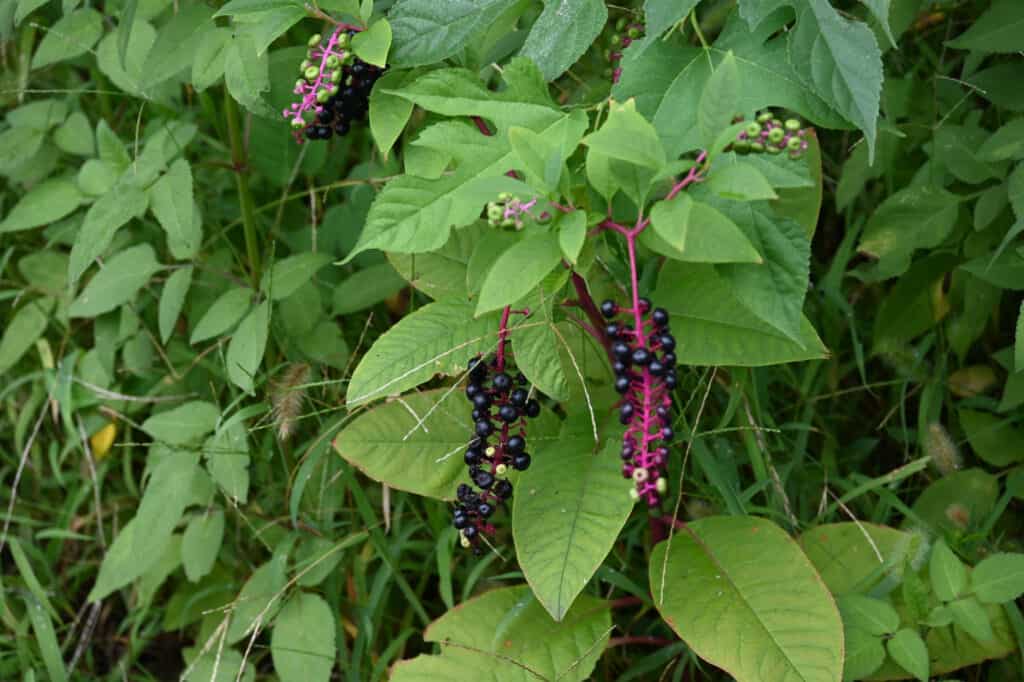
The American pokeberry or pokeweed is a dangerous plant that grows in clearings, fields, and woodlands.
©tamu1500/Shutterstock.com
4. Pokeberry
- Scientific Name: Phytolacca Americana
- Common Names: American pokeberry, pokeweed, poke salad, American nightshade, pigeon berry, skoke
- Plant Description: Pokeberry or pokeweed is an upright, branching plant with shiny green oval leaves and smooth red-purple stems. This plant also grows beautiful clusters of hanging green-to-white flowers that turn into dark purple berries by late summer. Pokeberry is sometimes confused with a similar plant called knotweed.
- Height at Maturity: Averages 4-10 feet high but can grow much taller
- Habitat: Fields, forest edges and clearings, woodlands, yards.
- Toxic Parts of Plant: Avoid all parts of pokeberry plants, whether the plant is alive or dead.
- Plant Poisoning Symptoms: Touching a pokeberry plant could cause redness, itchy rash, and blisters. Eating any part of a pokeberry plant could cause convulsions, diarrhea, difficulty breathing, headache, vomiting, muscle spasms, or loss of consciousness.
There’s no doubt that pokeberry or pokeweed is a beautiful plant with its reddish-pink stems and hanging clusters of berries that turn a deep purple by fall. But this dangerous plant in Louisiana can cause some troubling symptoms if touched or ingested, from an itchy rash to convulsions to unconsciousness.
Toxins in Pokeberry
The toxins in pokeberry plants to be aware of include phytolaccine, saponins, and mitogen. If ingested, phytolaccine could cause burning sensations in the GI tract and gastritis.
Fortunately, the berries of this plant aren’t as toxic as the leaves, roots, and stems. However, touching or eating the berries could still cause severe symptoms, especially if consumed in large quantities.
Pokeberry and Pets
All parts of the pokeberry plant are toxic to dogs. Here’s a list of possible symptoms of pokeberry or pokeweed poisoning in dogs, according to Pet Emergency Helpline:
- Blood pressure drop
- Diarrhea
- Excessive salivating
- Loss of appetite
- Tremors

The black nightshade shrub contains poisonous alkaloids that make this plant dangerous to humans, livestock, and pets.
©Omhans/Shutterstock.com
5. Black Nightshade
- Scientific Name: Solanum ptycanthum
- Common Names: American black nightshade, Eastern black nightshade, common nightshade, purple nightshade, deadly nightshade
- Plant Description: Black nightshade is a small upright shrub that grows as a short-lived perennial or annual plant. It produces tiny white star-shaped flowers in June that become poisonous green berries 4-5 weeks later. The green berries then mature to black or dark purple by late summer. In addition, this dangerous plant has smooth green stems and grows oval, pointed leaves that are slightly hairy underneath.
- Height at Maturity: Up to 4 feet tall
- Habitat: Disturbed and unmanaged areas like roadsides, fields, overgrazed pastures, and open waste areas.
- Toxic Parts of Plant: All parts of black nightshade plants can be toxic, but the leaves and unripe berries are particularly poisonous.
- Plant Poisoning Symptoms: Touching black nightshade doesn’t typically cause symptoms, but there is the risk of poisoning through cuts or scrapes on the skin. Eating any part of the black nightshade plant could cause sweating, dry skin and mouth, diarrhea, stomach pain, vomiting, confusion, hallucinations, and paralysis.
Black nightshade is one of the dangerous plants growing in Louisiana that’s also a common herb sometimes used in folk medicine. But unless you are educated and experienced with properly preparing this plant for herbal applications, it’s best to leave it alone. Symptoms from eating black nightshade leaves and berries could be very serious for humans, livestock, and pets.
Toxins in Black Nightshade
According to Mount Sinai Health System, the poisonous ingredients in black nightshade are atropine and solanine. Both are alkaloids (molecules containing nitrogen), and even small amounts of solanine are poisonous.
Did you know that plant alkaloids are part of a plant’s defense system against predators? For example, in the case of black nightshade plants, their poisonous alkaloids help protect them from insect pests and wild animals that might eat their berries.
Despite this plant’s best efforts to ward off berry eaters, animals like sparrows, wild turkeys, pocket mice, and moles enjoy snacking on black nightshade leaves or dark ripe berries.

The
elephant
ear plant has huge heart-shaped leaves that can cause a burning rash when touched with bare skin.
©komkrit Preechachanwate/Shutterstock.com
6. Elephant Ear
- Scientific Name: Colocasia esculenta
- Common Names: Elephant ear, taro, green taro, wild taro, malanga, caladium, dasheen
- Plant Description: Elephant ear plants are mainly green foliage perennials with huge textured heart-shaped leaves resembling elephant ears. These bushy plants have tall, thick stems and can spread 6 feet wide or more. The elephant ear rarely produces any flowers, but the blooms are yellowish-white if it does.
- Height at Maturity: 3-8 feet tall
- Habitat: Prefers moist soil and partly-shaded areas close to water, like marshes, lakeshores, canals, bogs, rivers, and streams
- Toxic Parts of Plant: Avoid ingesting any raw parts of elephant ear plants.
- Plant Poisoning Symptoms: Some people develop a burning skin rash after touching this plant, while others have no troubling symptoms. However, eating any raw part of the elephant ear plant can cause swelling of the mouth, lips, and tongue, excessive salivating, stomach pain, needle-like or burning sensations in the mouth and throat, nausea, and vomiting. Severe cases of plant poisoning could include airway obstruction.
Though its toxicity level is considered medium by some extension services nationwide, eating elephant ear plants can cause troubling plant poisoning symptoms. Also, touching the plant can cause some people to develop a burning rash that lasts for days.
Toxins in Elephant Ear Plant
Elephant ear plants contain calcium oxalate crystals (called raphides) in mainly their leaves and stem. These crystals cause burning or needle-like sensations on the skin, mouth, and digestive tract.
The calcium oxalate crystals are released from cells called idioblasts when they are chewed or otherwise crushed. So that’s how these toxic crystals become a threat to your skin, mouth, and inside your body.
Not only is elephant ear or wild taro a dangerous plant in Louisiana, but it’s also an invasive plant growing across the state. However, according to LSU AgCenter, researchers and conservationists are finding wild elephant ear populations across Louisiana falling prey to plant pests called planthoppers (Tarophagus colocasiae). Perhaps hungry planthoppers will keep the invasive elephant ear plant population from growing out of control.
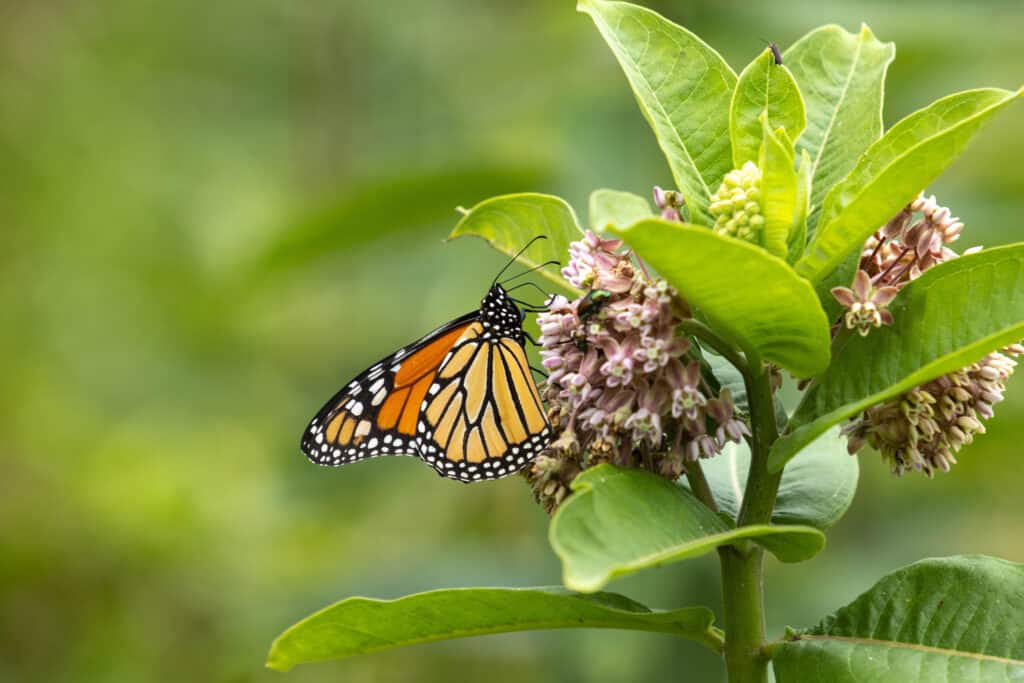
Wild milkweed can be dangerous for humans and some animals, but it’s an essential plant for bees and butterflies.
©iStock.com/carolmellema
7. Milkweed
- Scientific Name: Asclepias syriaca
- Common Names: Common milkweed, butterfly flower, silkweed, and Virginia silkweed
- Plant Description: Milkweed is a tall plant with thick stems and big oval leaves. It produces clusters of flowers at the top of the plant that are pinkish-purple and white. Milkweed also produces green then brown pods that fill with fluffy white seeds.
- Height at Maturity: 4-5 feet tall
- Habitat: Fields, pastures, prairies, and along roadsides
- Toxic Parts of Plant: The milky sap inside this plant’s leaves and stems is toxic to humans, livestock, and pets.
- Plant Poisoning Symptoms: Touching a milkweed plant could cause skin irritation and could lead to eye irritation if toxin transfers from your skin to your eyes. Eating any part of the milkweed plant can cause diarrhea, nausea, vomiting, diarrhea, stomach pains, drowsiness, and confusion. Severe cases could also lead to a slowed heart rate and seizures.
Common milkweed is a valuable plant for our ecosystem because of all the animals it feeds. In fact, the U.S. Forest Service states that milkweed feeds over 450 insects, including bees and butterflies (caterpillars). However, we mention milkweed in our list of dangerous plants that grow in Louisiana because its milky sap is toxic to humans, pets, and livestock if ingested.
One of the biggest risks with milkweed is accidentally mixing it with hay cuttings and other crops fed to horses. Unfortunately, horses and other types of equine animals, like zebras, tend to have strong allergic reactions to milkweed sap.
The good news is that milkweed does not have an appealing taste for most animals, and therefore, they leave it alone.
Toxins in Milkweed Plant
Milkweed contains a white sap with steroids called cardenolides. And it’s the cardenolides that cause allergic reactions like nausea, vomiting, and diarrhea.
Fun Fact: Monarch butterflies protect themselves from many predators (like birds) by storing milkweed toxins in their bodies. How does that help keep them safe? Milkweed tastes nasty to many animals, so these toxins make the butterflies taste awful to their predators too.
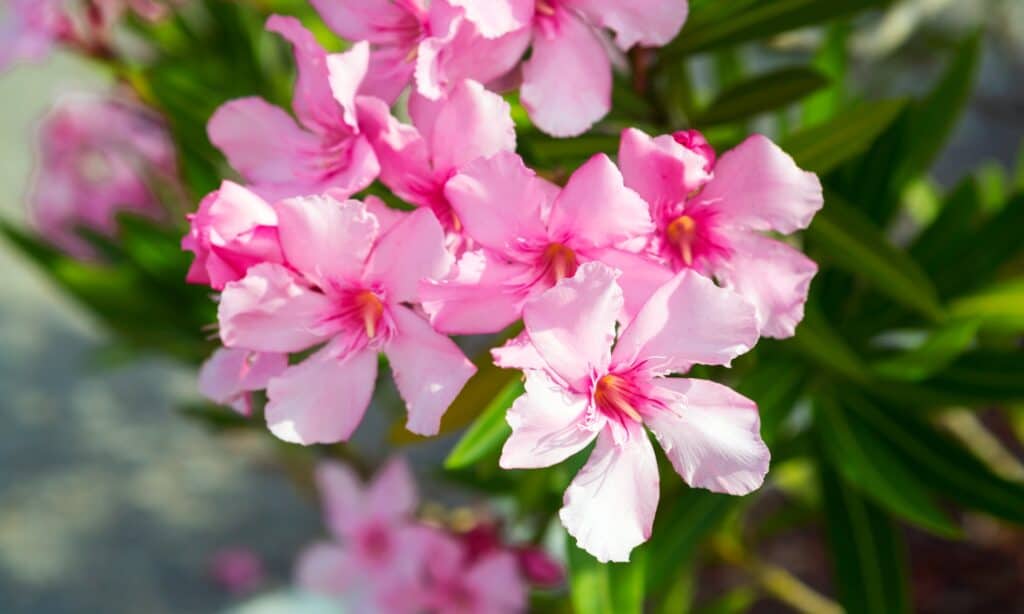
The oleander shrub is beautiful, but it’s also dangerous if touched with bare skin or ingested.
©iStock.com/Katrin_Timoff
8. Oleander

Oleander, with its exquisite tropical allure and ability to thrive in unfavorable soil conditions, presents itself as an ideal choice for a striking shrub to cultivate in your yard. Although, it can be toxic.
©Happy window/Shutterstock.com
- Scientific Name: Nerium oleander
- Common Names: Oleander, rose bay, rose laurel
- Plant Description: The oleander is a showy ornamental shrub that grows big, bushy, and full of blooms. Depending on the variety, it produces bright trumpet-shaped flowers in pink, yellow, red, or white. In addition, oleander has long, narrow green leaves on long, sturdy stems.
- Height at Maturity: 8-10 feet tall
- Habitat: Oleander thrives in sunny areas and moist soil near rivers and streams but also tolerates drought and dry soil well. This shrub often grows along roadsides and is popular for yards and gardens.
- Toxic Parts of Plant: Humans and animals should avoid touching any part of the oleander plant due to its poisonous sap.
- Plant Poisoning Symptoms: Touching oleander can cause skin redness and rash. Eating oleander can lead to many serious symptoms, including blurred vision, confusion, depression, dizziness, diarrhea, vomiting, headache, irregular heartbeat, and low blood pressure. In extreme cases, oleander poisoning could cause death. Pet symptoms of oleander poisoning could include abdominal pain, colic, excessive drooling, depression, and diarrhea.
With its stunning tropical beauty and hardiness in poor-quality soil, oleander seems like the perfect showy shrub to grow in your yard. But oleander should come with a warning label to beware of this dangerous plant that grows in Louisiana. Why? Because its beautiful blooms, along with its stems and leaves, contain toxic sap.
Touching oleander sap causes skin irritation and rash. But ingesting the sap can affect the GI tract, heart, nervous system, and even your eyes. In fact, symptoms like blurred vision, confusion, vomiting, and irregular heartbeat are just a few of the ones common with oleander poisoning.
Despite being dangerous, this ornamental shrub is a truly gorgeous, drought-tolerant, and low-maintenance plant. Its funnel-shaped flowers are long-lasting (blooming early summer to fall) and have a delightful scent.
So if you adore the beauty of bloom-heavy oleander shrubs (as most of us do), just be very careful when spending time near these plants. Also try not to touch your nose, mouth, or eyes after touching any part of this shrub.
Toxins in Oleander
Oleander contains steroids called cardiac glycosides, including digoxigenin, neriine, and oleandrin. Ingesting these compounds from oleander plants can be very dangerous for humans, pets, and livestock.
How to Beware of Dangerous Plants That Grow in Louisiana
As they say, knowledge is power. So learning about the dangerous plants that grow in Louisiana or any other state makes avoiding allergic reactions much easier. Plant field guides, plant identification apps, and watching educational videos all can help us identify the ones that might be poisonous if touched or ingested. In addition, county extension services and local libraries are also excellent plant-identification research and support resources.
Summary of the 8 Dangerous Plants that Grow in Louisiana
Here are the 8 Dangerous Plants that Grow in Louisiana:
| Rank | Plants |
|---|---|
| 1 | Poison Ivy |
| 2 | Poison Oak |
| 3 | Poison Sumac |
| 4 | Pokeberry |
| 5 | Black Nightshade |
| 6 | Elephant Ear |
| 7 | Milkweed |
| 8 | Oleander |
The photo featured at the top of this post is © Happy window/Shutterstock.com
Thank you for reading! Have some feedback for us? Contact the AZ Animals editorial team.







